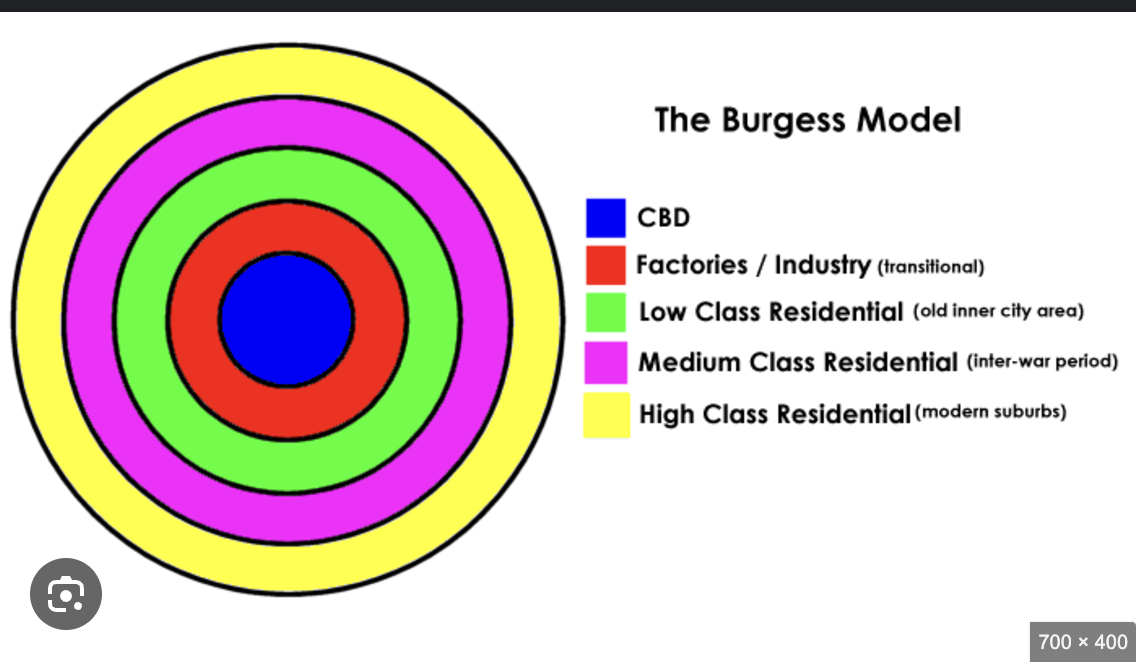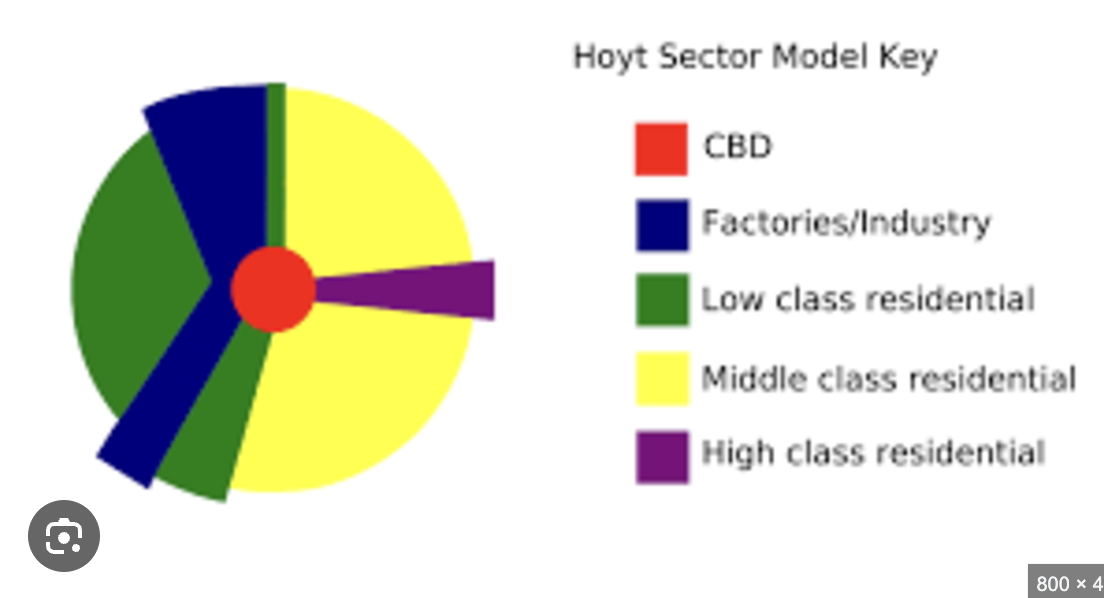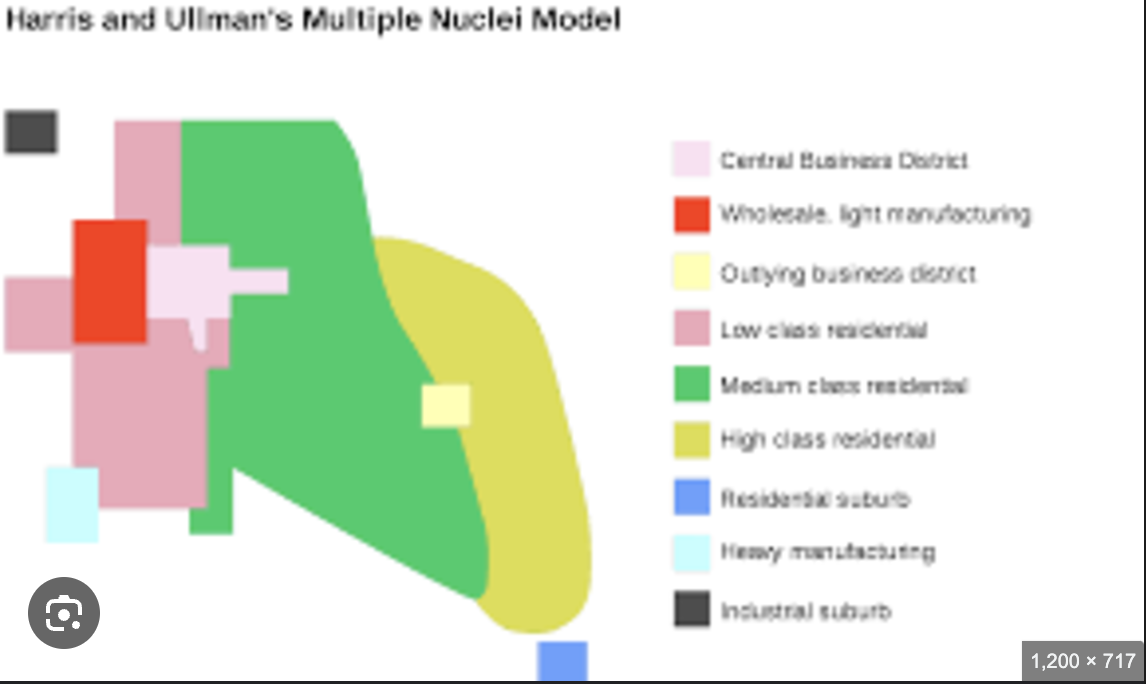Urbanisation
1/92
Earn XP
Name | Mastery | Learn | Test | Matching | Spaced |
|---|
No study sessions yet.
93 Terms
Urbanisation:
the increase in the proportion of a country’s population living in urban areas
Urban growth:
the increase in total population in towns/cities
Urban expansion:
a city/town’s increase in size
What continents have had relatively had the least urbanisation?
Europe and North America
London - 8.4 milli(1950) → 8.7milli (2015)
What continents have had the biggest, fastest changes in urbanisation?
Asia and Africa 1950
Lagos : 0.3 milli(1950) → 12.2 m (2015)
Why is urbanisation important in human affairs?
centres of political power and stable governments
better opportunities and healthcare ; better technology → live longer
good for business and company → organisation of economic production (London accounts for 22% of UK’s GDP) → brings up economy → multiplier effect
meet new people→ allows growth for newer ideas to better the city
more entertainment and social activities
better infrastructure
more money put in it
Megacity:
a city/urban agglomeration with a population of more than 10 million people.
Metacity:
a conurbation with more than 20 million people.
What are the 4 main forms of urbanisation?
urbanisation
suburbanisation
counterurbanisation
urban resurgence
Suburbanisation:
the outward growth of people,employment and services towards the edge of an urban area
counter-urbanisation:
population movement from large urban areas to smaller urban settlements/rural places
Urban resurgence:
population movement from rural back to urban areas (e.g. uni students), reviving inner city and CBD areas
rural-urban fringe:
the area at the very edge of the city beside the city
Counter-urbanisation:
movement of people from large urban areas to small urban areas or rural areas
Decentralisation:
movement of population and industry from urban centres to outlying areas
movement of government buildings/company headquarters away from country’s central area
Deindustrialisation:
the loss of jobs in the manufacturing sector
later half of 20th century in the UK
Edge city:
a self-contained settlement away from the city boundary but classified as a city in its own right.
Gentrification:
the buying and renovating of buildings, particularly in run-down areas, by wealthier individuals
Characteristics of suburbanisation:
outward growth of urban development
growth of public transport systems - more railway lines and arterial roads - allows wealthier workers to live further away but have a direct route
Suburbanisation in UK :
(1930s)→past urbanisation meant planing controls and urban growth only occurred on main roads →ribbon development
ribbon development became a cause for concern with more growth→ green belts created as open space areas and low density land controlling further development
(1950 onwards) →suburban expansion not only increased but better controlled ; large scale construction of council homes built on suburban fringe
(1970s) →move to house ownership on urban fringe, with more land for gardens and open space
with more cars, there was more land available for car parking and with more development of factories and car parks, the strict control of green belt was ignored
Effects of green belt:
new housing estates
local shopping centers
more people move to suburbs for quieter,less congested areas → less crime, key benefits of being rural-urban fringe
well-established housing
urban sprawl
environmental impacts
as wealthier move out, poor remain in inner city (social segregation)
funding towards suburbs than inner city
Los Angeles - suburbanisation example
attracts millions to the “Hollywood dream” → pop. of 24 million
half a million people arrived within 40 years from the arrival of the transcontinental train
people came for employment in the early 20th century within the discovery of oil, etc.
as suburbs were far from city, safe and more space → better quality of life with accessible transport to city → people moved outwards
Push factors from inner city: semi-derelict, poor city , high crime rate, pollution
“donut city” - hole in the middle
increasingly large suburbs called edge cities developed on freeways (e.g. Ontario)
social segregation → migrants migrate to the middle in ethnic enclaves, searching hard for work, with water, waste and energy issues too.
Characteristics of counter-urbanisation:
migration to smaller urban settlements or rural areas - growth in rural areas beyond main city
difference between rural and urban reduced
Causes of counter-urbanisation:
escaping air pollution, dirt and crime
aspire the peace, clean rural environment
land and house prices cheaper
tech improvements mean freedom of location
Cause of suburbanisation:
Greater value for money in house buying (bigger houses and gardens)
Quieter and safer.
Good transport links to the cities.
Greater car ownership.
Technology (internet) allows working from home.
Effects of counter-urbanisation (on the outlying areas):
rising demand for second homes and earlier retirement → direct consequence of rising levels of affluence
economic difficulties for agriculture
affected layout for rural settlements
tension between newcomers and locals → despite new people, local services may close down
Counter urbanisation of Melbourne, Australia:
>60,000 people left Melbourne during 2020-2021 ; first time regional population is higher than capital
away from claustrophobic city and since much work was finished during Covid, many left unemployed, having to move out
Characteristics of urban resurgence:
regeneration of an urban area which was previously in decline
city becomes more attractive, developing strong business sectors and increasing population
may still contain old industrial buildings, which have been repurposed.
Causes of urban resurgence:
often driven by gov-led regeneration schemes
redevelopment by private companies
city life more attractive→ more in-migration
major sporting events can catalyse regeneration schemes (e.g. Olympics)
Effects of urban resurgence:
greater pressure on urban infrastructure→housing demand increases→housing prices increase
increasing inequality between rich and poor
young people who moved in cities remain to start families→ natural increase
increased demand for services and more prosperity
Example of urban resurgence : Central Birmingham
Jewelry Quarter - in 1900s, over 20k people worked in making → during Blitz sharp decline in area’s fortunes → in early 2000s large-scale improvements → loft-style apartments, vibrant hubs for young people→urban resurgence
Urban sprawl:
the spread of an urban area into the countryside
Fortress landscapes:
landscapes designed around surveillance, protection and security
World cities:
interconnected global economic centres that have significant influence on the world economy
Why is it difficult to measure urban growth?
classification of urban dwellers depends on census definitions of urban areas, varying from country to country
Causes of urban growth:
natural increase:birth rate>death rate
urban areas have young age profiles →migrate for higher paid jobs→migrants are in their fertile years → high rates of natural increase, like in Wandsworth
Rural - urban migration →when people move temp/permanently from rural to urban
Push factors in LICS for urban growth:
bad weather - desertification
lack of jobs
isolation
lack of transport
education
“better quality of life
inadequate medical provision
Pull factors in LICS for urban growth:
better transport links
better services
more housings
high-paying jobs
informal sector work
Consequences of urban growth:
congestion/pollution/littering - pressure on local services
overpopulation
cultural diversity
more multiplier effect
increased house/land prices - increased demand
loss of natural landscapes/green spaces (URBAN SPRAWL)- more likely in LICs due to less planning
informal housing
more competition
high unemployment/under employment(people not making full ability of their skills/abilities)
Central Business District (CBD):
central area containing all major shops, offices and entertainment facilities
Inner city zone:
area of old housing and light manufacturing industry
dates back to Industrial revolution
within last 3 decades, most British people have seen some sort of regeneration here
Residential zone:
housing that increases in size and price as you move towards outskirts
urban regeneration schemes and gentrification means that in “low class residential” areas mean that wealthier people can live there.
Green area zone:
e.g. parks in an urban area
Out-of-town retail developments:
large shopping complexes located outside of traditional city centers
originally developed by large supermarkets, which expand to non-retail units and entertainment facilities and etc.
have had a negative impact in some places
in 1994, UK actively discouraged it
Where is Bangalore?
South India, Karnatka
Besides Andhra Pradesh and Tamil Nadu, not surrounded by sea
Trickle down effect:
the diffusion of the benefits of urbanisation, such as prosperity, to poorer people.
Knowledge economy:
an economy based on creating, evaluating and trading knowledge/high level skills
What processes drive Bangalore’s urban growth:
political processes
economic processes
social processes
technological processes
demographic processes
What is the Burgess model(LOOK AT IT ONLINE/BOOKS):
based on Chicago
did not take into account transport

What is the Hoyt model(LOOK AT IT ONLINE/BOOKS):
did not take into account wind and transport
did not take into account cars

Political processes in Bangalore:
Texas Instruments was the first large TNC to move in, but only in 1990s that IT rapidly expanded
1970s- far-sighted state gov set aside land for high tech business park
Economic processes in Bangalore:
economy relies on people and skills rather than manufactured goods
capital of aeronautical, automotive, biotechnology, electronics and defence industries
Social processes in Bangalore:
growing social divide and inequality gap between so-called middle class and those at the bottom of caste system
less than half of slum dwellers have access to sanitation, clean water or electricity
Bangalore favours the wealthier and the growing economy over wider society, by building more expensive housing that the poorer in society cannot afford.
Slums in Bangalore tend to be situated further away from inner city, supporting Hoyt’s model
Technological processes in Bangalore:
city’s 200 engineering colleges and many unis provide highly skilled workforce
growth in home-grown IT companies (e.g. Keonics)
Demographic processes in Bangalore:
population inn 2015 was 10.8 million, more than double of 2001
Bangalore’s migrants are quite young, therefore population momentum will almost guarantee continued population growth for several decades.
Protectionism:
the theory /practice of shielding a country’s domestic industries from foreign competition by taxing inputs
Productivity:
a measure of how efficiently a person completes a task
Outsourcing:
a cost saving strategy
companies arrange for goods/services to be provided by other companies, usually at locations where costs are lower.
Urban prairie:
when natural processes take over a building/urban space
What are some factors as to why there was deindustrialisation after WWII
reduced need for labour due to rapid mechanisation
reduced demand as household incomes increased and money was spent on services
globalisation of manufacturing, therefore no need for employing large numbers of workers in HICS.
Increased costs of raw materials and poltitical decicion making (e.g. envirnoment decisions)
How many people in inner-city areas lost their jobs due to deindustrialisation in the UK?
2 mil
Why was deindustrialisation so severe in the UK in the 1950s onwards?
high levels of protectionism
trade unions being resistant to changes in industrial practices
UK investors investing abroad
outdated plants and machinery
unfavourable exchange rates
Social characteristics of urban decline:
poor quality of housing
higher crime rate →increased fear of crime → segregation
less services
Geographical characteristics of urban decline:
inner city decline
Demographic characteristics of urban decline:
ethinic minorities stay → racial segregation
richer people mkove out, more working class people in area
Economic characteristics of urban decline:
lack of employment → less taxes for council
youth unemployment
lower value housing
Political characteristics of urban decline:
often areas are forgoteen
higher political extremism
civil unrest
Physical characteristics for urban decline:
derelict buildings
demolished buildings - >poorer qualty of housing
DIversification:
diversity in different sectors of work/industry
in Detroit, all money was on car industries - lack of diversification
Decentralisation:
movement of population and industry from urban centre to outlying areas
Urban form
The physical characteristics that make up a built-areas, including shape, size, density and configuration of settlements
is urban form more influenced by physical or human factors?
human factors as technology has allowed humans to conquer some physical factors
Bid rent theory:
the price and demand for real estate changes as the distance from the CBD increases
different land users such as industry, residential and retail will compete with one another for land close to CBD, as normallly there best land and comms links
Land Value in Urban forms:
with increasing distance from a central point known as the Peak Land Value Intersection ( PVLI), land value declines
what is the most valuable land in urban forms?
PVLI / CBD
Distance Decay:
the interaction between 2 zones of area declines as the distance between them increases.
Burgess model order:
high class housing→middle class housing →working class housing → factories/industries→ CBD
Twilight zone:
an urban zone of a city where industry and residential areas mix and the population is often transitory and constantly moving
What models is Bid Rent theory based on?
3 land use models- Burgess, Hoyt and Ulman
Harris and Ulman’s multiple nuclei model:
attempts to explain structure of city taking into account complexity and growth over time
activities and land scatter CBD
scattered activities attract people from surrouding areas as smaller nuclei, until they grow in importance and influence land value and the growth of activities around them

WHy may bid rent throey model not be fully accurate:
retailer have moved to locations where there is more space., cheaper
secondary land value peaks - areas of elevated land price, edge of cities , key transport routes converge increasing accessibility
regeneration of CBD and innercity areas push land price up
modern industries like science parks not in models
does no work well for LICS, squatter settlements
Tokyo’s urban form:
no CBD - corridors
tech centre
WHy do LIC megacities have different urban forms to HICS:
HICs more likely to have historical places due to being established earlier
more socieal inequality in LiCS and NEES due to rapid developmet - social inequality
LICS have to accustom to mass migration very quickly for urban centre → poor planning can raise many issues
Demographic characteristics of Detroit’s decline:
1910-1970: millions of African Americans from the South migrated to Detriot in pursuit of manufacturing opportunities → racial tensions
36% population below poverty level
too much infrastructure relative to level of demand → unused builidngs
Characteristics of a world city (using London as an example):
dominance of national region with great international significance - London
hQs of international companies - Google, MCdonalds
Centres of media and communications for global networks - BBC
Centres of new ideas and innovation in business, economics culture and politics → London was world’s most innovative city ; unis(Imperial)
Physical characteristics of Detroit’s decline:
white richer families moved to suburbs, city’s poor stayed in Detroit
very large state - 138 square miles
high levelf of pollution and contamination→ in 1948, oil pollution killed 11,000 winter ducks
Political characteristcs of Detroit’s decline:
“crime capital”- 7 out of 10 crimes unsolved
poor public realm→lack of vision+investment
poor urban planning
Economic characterics of Detroit’s decline
(1970s) when car industry experimented with automation, 10s of 1000s of jobs lost → industry shrank more with energy crisis→ 1980s economic recession
unemployment rate:19%
lacked industrial diversification ; too dependant on automation
Social characteristics of Detroit’s decline:
racial tensions
average police response time - 58 minutes
Contemporary characteristics of megacities:
environmental problems
car-dominated urban form - more accessible, higher
residential differentiation
Differences between a megacity and world city:
megacities predominantly known for its high pop. of >10million
world city predominantly known for large economy and strong influence globally.
London - world city
Osaka - megacity
Urban morphology:
The study of the form of human settlements and the process of their formation and transformation, with refrerence to spatial and structure organisation.
many settlements have their form and morphology controlled by mix of both physical and human factors
Phys factors: Valleys, coastlines, mountains can restrict urban growth, and promte growth in others by offering transport, communication links, natural resources
human factors: political decicions, econ factors (e.g. land value)
technology has allowed humans to bypass some phys restrictions to city growth.
Is Bangalore a megacity?
YES